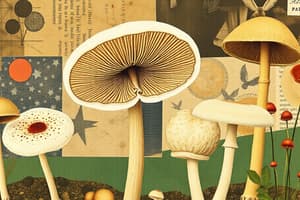Podcast
Questions and Answers
What is the term for the shape, size, color, and texture of fruiting bodies in fungi?
What is the term for the shape, size, color, and texture of fruiting bodies in fungi?
- Microscopy
- Chemical Tests
- Cultural Characteristics
- Morphology (correct)
What type of fungal identification involves examining spores, hyphae, and other microscopic features?
What type of fungal identification involves examining spores, hyphae, and other microscopic features?
- Microscopy (correct)
- Morphological Identification
- Molecular Identification
- Physiological Identification
What is the term for the pattern of gills or pores on the underside of fungal caps?
What is the term for the pattern of gills or pores on the underside of fungal caps?
- Stipe Characteristics
- Spore Print Color
- Veil Remnants
- Gill or Pore Arrangement (correct)
What tool is used to obtain a spore print?
What tool is used to obtain a spore print?
What type of fungal identification uses DNA sequencing techniques?
What type of fungal identification uses DNA sequencing techniques?
What is the term for the remnants of the veil that covers the gills or pores in immature fungi?
What is the term for the remnants of the veil that covers the gills or pores in immature fungi?
What is a key identification resource for fungi?
What is a key identification resource for fungi?
What is the term for the examination of fungal growth patterns, color, and texture on agar media?
What is the term for the examination of fungal growth patterns, color, and texture on agar media?
Flashcards are hidden until you start studying
Study Notes
Characteristics Used in Fungal Identification
- Morphology: Shape, size, color, and texture of fruiting bodies (e.g., mushrooms, conks)
- Microscopy: Examination of spores, hyphae, and other microscopic features
- Chemical Tests: Reactions to various chemicals, such as potassium hydroxide (KOH) or ammonium hydroxide (NH4OH)
- Cultural Characteristics: Growth patterns, color, and texture of colonies on agar media
- Ecological Associations: Habitat, substrate, and associated organisms
Types of Fungal Identification
- Morphological Identification: Based on macroscopic and microscopic characteristics
- Molecular Identification: Using DNA sequencing techniques, such as PCR and DNA barcoding
- Physiological Identification: Based on growth responses to different environmental conditions
Important Features for Fungal Identification
- Spore Print Color: Color of spores deposited on a surface
- Gill or Pore Arrangement: Pattern of gills or pores on the underside of fungal caps
- Veil Remnants: Remnants of the veil that covers the gills or pores in immature fungi
- Stipe Characteristics: Shape, size, and color of the stalk
- Flesh Characteristics: Texture, color, and reaction to chemicals of the fungal flesh
Tools and Techniques
- Hand Lens or Magnifying Glass: For observing macroscopic features
- Microscope: For examining microscopic features
- Spore Print Kit: For obtaining a spore print
- Chemical Reagents: For performing chemical tests
- DNA Extraction and Sequencing: For molecular identification
Key Identification Resources
- Field Guides: Illustrated guides for identifying fungi in the field
- Taxonomic Keys: Systematic guides for identifying fungi based on characteristic features
- Online Databases: Collections of fungal data and identification resources, such as GenBank and MycoBank
- Expert Consultation: Collaboration with experienced mycologists and taxonomists
Characteristics Used in Fungal Identification
- Fungal identification involves examining morphology, including shape, size, color, and texture of fruiting bodies like mushrooms and conks.
- Microscopy is used to study spores, hyphae, and other microscopic features.
- Chemical tests involve observing reactions to chemicals like potassium hydroxide (KOH) and ammonium hydroxide (NH4OH).
- Cultural characteristics, such as growth patterns, color, and texture of colonies on agar media, are also examined.
- Ecological associations, including habitat, substrate, and associated organisms, are considered in fungal identification.
Types of Fungal Identification
- Morphological identification is based on macroscopic and microscopic characteristics.
- Molecular identification uses DNA sequencing techniques, including PCR and DNA barcoding.
- Physiological identification is based on growth responses to different environmental conditions.
Important Features for Fungal Identification
- Spore print color is an important characteristic, as different species produce spores of distinct colors.
- The arrangement of gills or pores on the underside of fungal caps is a key feature.
- Veil remnants, which are remnants of the veil that covers gills or pores in immature fungi, are also important.
- Stipe characteristics, including shape, size, and color, are used in identification.
- Flesh characteristics, such as texture, color, and reaction to chemicals, are also considered.
Tools and Techniques
- Hand lenses or magnifying glasses are used to observe macroscopic features.
- Microscopes are necessary for examining microscopic features.
- Spore print kits are used to obtain a spore print.
- Chemical reagents are used to perform chemical tests.
- DNA extraction and sequencing are used in molecular identification.
Key Identification Resources
- Field guides provide illustrated guidance for identifying fungi in the field.
- Taxonomic keys are systematic guides for identifying fungi based on characteristic features.
- Online databases, such as GenBank and MycoBank, provide collections of fungal data and identification resources.
- Expert consultation with experienced mycologists and taxonomists is also an important resource.
Studying That Suits You
Use AI to generate personalized quizzes and flashcards to suit your learning preferences.



